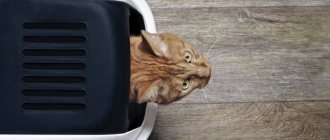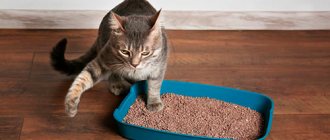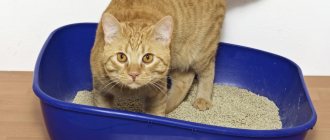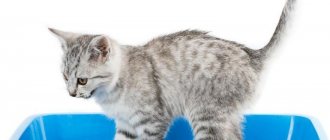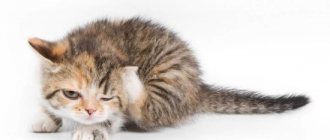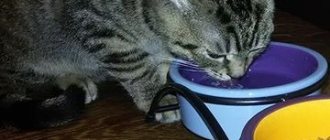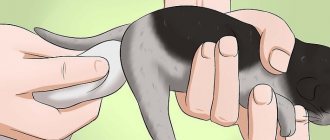Some people, in order to somehow brighten up their lives, acquire small kittens. Little kittens are very similar to little children. And they, like children, may have problems associated with poor bowel movements. In other words, constipation may occur - a situation in which the kitten cannot go to the toilet in a big way . This problem can appear as a result of stress experienced by the animal or a change in diet, but it is worth noting that these are just a few of the reasons that can cause constipation in the kitten.
Why does a cat get stressed when moving?
Imagine that you live in one place all your life, don’t go anywhere and only see the world around you from the window.
At the same time, the world outside the window is safe; when you look at it, you feel the smell of home and you do not have a feeling of danger. But in one moment everything changes - new surroundings, new smells, new life. Of course, against the backdrop of such changes, stress arises. As you can understand, above we described the life of your pet that was relocated. After moving, the cat (or cat) finds himself in a place where everything is unfamiliar to him. Initially, he has only one instinct - to protect himself.
Signs of constipation in kittens
Constipation can rightfully be called one of the most common difficulties that a growing animal has to face. You can determine if there are difficulties with bowel movements and help your kitten by noticing the following signs:
- frequent attempts to defecate;
- dry and hard excrement;
- noticeable discomfort of the animal during the next attempt to empty the intestines (plaintive meowing, fear);
- the presence of bloody or mucous discharge in the stool;
- complete lack of appetite;
- weight loss.
Cat behavior after moving
Immediately after moving to a new apartment, the animal is usually slaughtered in a place where it feels safe. For example, under the bed or between cabinets. A small space around a cat allows her (him) to feel safe.
The best decision on the part of the owners at such a moment is to make the place chosen by the pet as comfortable as possible for it. For example, put his favorite blanket in this place or put his scratching post - any items that you took from the old house will do.
Before moving into a new apartment with a pet, we recommend that you try to cover all the places where the cat can “hide” with danger to its health. It is best for the animal to choose a place from where you can see it, and where it can see you and the environment. A bad option for the first place for a cat to stay in a new apartment is behind the sofa, bed and other furniture. This will not only be additional stress for the animal, the lack of visual contact with the owner, but also potentially traumatic.
What to do if your cat doesn't eat after moving
The most important thing is not to panic and not to try to force feed the animal. Remember the animal's instincts. When a cat gets so hungry that it can no longer endure it, it will go in search of food; the animal cannot starve itself to death.
To prevent your cat from having to go far to look for food, place two bowls next to it - one with food, the other with water. It’s better to put your pet’s favorite treats so that he can quickly respond to them and eat them.
Note that each animal has its own character and its own opinion on how to act after moving. Some cats, on the contrary, after moving, try to immediately eat for the future, so that if such stress suddenly occurs again in the next few hours, they will not remain hungry. So, if your pet has already eaten his allotted amount, but clearly wants more, be sure to feed him extra, this will help him relieve stress.
The cat does not go to the toilet after moving
As in the situation with food, the best recommendation in this case for animal owners is to simply wait. But to prevent your pet from spoiling your new apartment, we recommend:
If your pet hides in a corner, you need to place an old tray near it. If you want to place the tray in a different place in the future, you can accustom your cat to this after the pet’s stress has passed.
If the cat went to the toilet in the wrong place, you need to reproach him, do not let him get used to such permissiveness.
Don’t forget to cover from potential “damage” all the furniture in the house that could absorb the smell if the animal doesn’t immediately go where to go to the toilet.
As with food, a cat in a new place may not go to the toilet for 3-4 days due to stress. This is quite common practice. If you create comfortable conditions for him to go to the toilet by placing his tray nearby, he will certainly do it.
Treating constipation in kittens with massage
A kitten cannot go to the toilet often due to various diseases of the gastrointestinal tract. In this case, treatment procedures and medications depend on medical prescriptions.
A kitten that is unable to empty its bowels on its own urgently needs the assistance of its owners. This is especially true for small kittens, the young cat refused to properly care for them due to inexperience and immaturity. The procedure is not difficult, the main thing is to follow all the tips below for babies aged from one day to three months:
- Before starting stimulation, it is extremely important to position your pet comfortably. The most suitable position is considered to be when the kitten lies on the left hand, with its butt turned towards the owner. You should not put too much pressure on the fragile body of your furry baby, but you should squeeze it in such a way as to eliminate the possibility of falling out.
- Prepare a pre-moistened napkin or clean cloth. By placing it on the right side before starting the procedure, the cloth will be useful for stimulating the anus. This needs to be done by the kitten in order to replace a completely natural process usually carried out by the mother.
- You should start the massage by moving your right hand with a napkin towards the kitten’s anus. Stimulating the animal's anus with such a simple massage will help relax the animal's muscles, since it will be an imitation of licking by a cat.
- The massage can occur every day and last about a minute. If results from rectal stimulation are not achieved, you should visit a veterinarian. The animal must definitely go to the toilet for any need.
- After changing the position of the rag on your hand and turning it with the clean side, it is important to continue massaging the kitten's anus. A towel that gets dirty needs to be turned over from time to time. Once cotton swabs, which many people prefer to fabric scraps, become dirty, they should be thrown away immediately. By the way, it is advisable to take into account that kittens of the newborn period have soft stools. The transition from liquid food to more solid food occurs after the second month of a pet’s life.
When do you need veterinary help?
Many owners call a veterinarian for their pet on the first or second day after moving, when they see that it does not leave the corner for a long time. Or they go looking for advice on forums on what medications they can give to their pet. We categorically do not recommend doing this.
You should call a veterinarian or take your cat to the clinic only if:
- There are obvious signs of poor health of the animal: constant nausea, severe drowsiness, loss of tufts of hair;
- The animal does not leave its corner for more than 4 days and refuses to eat and go to the toilet;
- The animal is lethargic, it does not try to defend itself when you want to pick it up.
There is no point in giving the animal pills and injections once again. A trip to the vet is another stressful experience for your pet, so it’s best to avoid it.
Source
How to help your baby, what to do at home?
Methods of assistance largely depend on the age of the pet. It is important to remember that the baby may not like any actions, so he will desperately resist. You can cope with constipation in kittens at home by following the recommendations of specialists.
Newborns and kittens up to 1–1.5 months
When, for some reason, a cub is left without a mother at the age of less than 1.5 months, it needs human help. A one-week-old baby cannot eat, drink or go to the toilet on his own. The stomach and intestines of kittens during this period are not yet fully functioning. Replacing cat milk with other products may cause diarrhea or constipation in the babies. If diarrhea develops, dehydration occurs, and constipation leads to severe intoxication. Any disturbance of bowel movements at this age is a threat to the life of babies.
During the first weeks after birth, kittens produce only enzymes that process dairy products. To feed one-week-old babies, it is better to use a cat's milk replacer, which can be purchased at veterinary stores.
Before each feeding, kittens need to massage the abdomen and genitals with a cotton pad dipped in warm water. This stimulation will help them empty their bladder and bowels. For constipation, it is recommended to give Duphalac to one-week-old babies.
Month-old kittens are already beginning to react to the smell of meat products. Their diet includes minced meat that has undergone heat treatment or high-quality kitten food. When introduced to new food, bowel problems sometimes occur. To avoid constipation, you need to monitor the amount of water your babies consume. If the kitten does not poop, you need to give it fermented milk products. They will help normalize stool.
If there is no effect, you can use Duphalac. However, laxatives will not help if foreign objects are present in the gastrointestinal tract. In such cases, experts advise using linseed or vaseline oil.
Kittens aged 2 months and older
By 2 months the pet becomes completely independent. He devotes a lot of time to studying the world around him and playing games. At this age, kittens most often swallow foreign objects, which cause problems with stool. If your pet does not poop for a long time, although its diet has not changed, you should consult a veterinarian. In some situations, objects are so large that they can only be removed through surgery.
If your baby rarely walks after trying a new food, then you need to give him more to drink. The body will gradually adapt to the new food, and the problem will disappear. In addition, if defecation is difficult, doctors recommend giving kittens a abdominal massage, stroking it clockwise. This massage promotes the movement of feces and their exit from the body.
Why doesn't a kitten go to the toilet after moving?
0. Before your cat arrives, ALWAYS check if there are any inaccessible or hard-to-reach places in your house where a small animal can get through (batteries, gypsum board housings, places with a lot of wires and expensive household appliances, pipes, unfinished repairs, etc. ) If the cat gets in there (and he will 100% get in there), you won’t be able to lure him out of there by any force.
1. Immediately after arriving at a new home, the cat will hide in the first hard-to-reach place that happens to be on its way. This could be a shelf in a closet, a place behind the toilet, a gap between a refrigerator, closet or sofa and a wall, etc. This will be his habitat for the next few weeks. Place a tray with filler and a bowl of water next to this place. DO NOT pull the cat out of its shelter, do not try to forcefully introduce it to life, do not look into the hole, do not pet it, do not try to lure it with food, force feed it, and do not try to drive it out of there. Let the cat sit in his shelter for as long as he needs to understand that it is safe here. Then he will slowly go out, curiosity will drive him to investigate. BUT at the same time, the cat should always be able to return to the place that he considers safe, where you do not see him and he does not see you. Do not block his escape route, give him the opportunity to believe that he can hide in the house.
2. For the first 2-3-4 days, the cat may not eat, drink or go to the toilet. DON'T BE SCARED - THIS IS NORMAL. The animal experienced stress during the move and continues to experience it in the new place. New smells, noises, images - all this frightens him and completely disorients him. No feeling of hunger will force him to leave the shelter until the stress subsides at least a little and he gets used to it. All animals have their own character, they all need different time to get used to. Try to be patient. Don't worry, a cat is practically incapable of starving itself. Only a person can consciously refuse food. The instinct of self-preservation will win.
3. At first, the most important thing is to control where the cat goes to the toilet. The tray should be located so that the cat can reach it with minimal effort - that is, as close as possible to the place where he is hiding. If the litter box is at the other end of the room, he will not go there out of fear, but will simply go to the toilet where he thinks it is safe. He will not put himself in danger and will simply find a safe place to go to the toilet. Try not to force your cat to choose between the usual litter box and the fear of being discovered. Since the animal can behave unpredictably, just in case, remove all valuables from the floor, if possible cover the furniture with plastic, etc. If your cat goes to the toilet in the wrong place several times, try to change something. Tray size, location, type of filler, etc. If possible, place the cat in a limited space with the tray. At the shelter, all animals use a litter box, so this could just be a stress-related glitch.
Causes of stool retention in a kitten
Babies often experience difficulty with bowel movements in the first days and months of life. Constipation in a kitten can be caused by several reasons:
- Lack of maternal care. In newborn babies, feces and urine are released only with the help of the mother: while licking the kittens, she massages their intestines and bladder. If kittens are separated from the cat before the age of 3 weeks, then they require human assistance, otherwise constipation cannot be avoided. However, sometimes the mother does not take care of the offspring, which also provokes constipation in kittens.
- Poorly balanced diet. Starting an independent life, kids get used to a new type of food. It is harder to digest food or natural products than mother's milk, so constipation often occurs in kittens at the age of 1–2 months. To avoid problems with bowel movements, you need to introduce foods into your diet gradually.
- Lack of water. Dry food often causes constipation in kittens if they don't drink enough. It is important to ensure there is fresh water in your pet's bowl. If the baby has not yet settled into the house, then you need to force him to a bowl of water after feeding and between meals.
- Lack of movement. Keeping kittens in small spaces can lead to fecal stagnation. To ensure good intestinal motility, it is necessary to eliminate restrictions that prevent the pet from actively moving and playing.
- Stress. The cause of stress can be moving to a new place, being separated from the mother, the appearance of other animals in the house, a visit to the veterinarian, or traveling on public transport. As a result of the experience, the baby may lack not only stool, but also appetite and interest in games.
- Intestinal blockage. While playing, kittens often swallow small inedible objects - children's toys, beads, pieces of stuffing. In this case, constipation may be prolonged, and the cause can only be determined after examination and examination by a veterinarian. In addition, the accumulation of hair in the stomach or eating bones can cause intestinal blockage.
- Diseases. Constipation can be caused by inflammatory processes in the gastrointestinal tract, the appearance and growth of tumors and polyps. In some cases, difficulty defecating occurs due to helminthic infestation.
- Dirty tray. Cats are very clean, so for some of them one litter box is not enough. If a pet pees and the owner does not clean its litter box in time, the baby may not poop until the litter is replaced.
Why doesn't the kitten poop and what to do in such a situation?
Has your kitten not pooped for a day, a few days, a week? This problem is very common because... The digestive system of small kittens already works imperfectly, and after moving to a new home, difficulties begin even more so, because the nutritional system often changes, and stress takes its toll. We will not touch upon the issue of kittens under one month of age, because... this is a special topic. Let's talk about those who are older.
Why the kitten does not go to poop: the main reasons
Let's figure out in order what the problem might be. But first, make sure that there is no situation where you simply haven’t found the place where the animal is doing this. If a kitten does not go to the toilet, this sometimes means that he has found a secret place for himself.
One of my cats, when we took her in, did not go to the toilet for 2 weeks. More precisely, we thought so. But after 2 weeks it turned out that she had taken a fancy to the suitcase under the wardrobe. The suitcase kept everything inside and nothing was visible. Oddly enough, we didn’t smell it either, although no one had complained about the sense of smell before. When we noticed that the cat was coming out from under the wardrobe and climbed in, we saw that the suitcase had turned into a slurry of urine and feces.
A very small kitten cannot poop without help
Very small kittens do not know how to go to the toilet on their own. The mother cat licks their anuses, stimulating defecation. If there is no mother or the mother does not care enough for the kittens, the massage should be done by the breeder. Massage the abdomen and the genital and anal areas after each feeding. On average, a kitten should go to the toilet 3 times a day.
Peristalsis did not turn on
Young kittens (usually from 1 month to 2-2.5 months) may suffer from constipation when their gallbladder does not yet work properly and/or peristalsis has not started. In this case, inflammation of the intestinal walls may occur. Signs of the condition are as follows: the kitten eats poorly, is lethargic and thin, develops slowly, and when you palpate the abdomen, lumps are felt (like pebbles). These kittens usually do not have a bloated stomach, despite being constipated.
This condition, if not eliminated, is dangerous. Sometimes a sorbent helps a kitten, which collects everything accumulated and removes it. If after this everything starts to improve within a day or two, then you can still drink the sorbent for 2-3 days - and then peristalsis will begin to work on its own. But if the sorbent does not help within 1-2 days, this means that the condition is more serious and you will need injections and oral medications. You do not need to prescribe such medications yourself - contact your veterinarian.
Artificially fed kitten
Artificially fed kittens often have the problem of constipation. In this case, a glycerin suppository can help. It must be purchased at a regular human pharmacy, where candles for newborns are sold. But this candle is too big for a kitten, so first you need to prepare it properly. Heat the candle at room temperature. When it softens enough, stick an insulin syringe into it without a needle and add glycerin to it. Then the glycerin needs to be squeezed back out of the syringe, forming a microcandle to the size of the kitten’s anus. When the candle hardens a little, it needs to be lubricated with Vaseline and inserted into the anus. The kitten will poop in a few minutes.
After moving, the kitten does not go to the toilet due to stress
When you adopt a kitten and he doesn't poop, you're wondering what to do? I immediately want to fix something, because not going to the toilet for a long time is harmful. However, you should know that kittens, when they get to a new home, rarely go to the toilet for the first week, because... they are stressed. But usually the situation is resolved in 3-5 days.
Accordingly, if the kitten does not poop for a day or two, and also if the kitten does not poop for 3 days after moving, this is not yet a problem. The problem is if the kitten doesn’t poop for 4 days or 5 days, then it’s worth asking what to do and what are the reasons for such rare bowel movements.
Why doesn't the kitten poop for 1 day?
Even if the animal successfully survived the stress and began to visit the litter box regularly, failure may occur over time. As a result of stress or poor nutrition, a kitten may not go to the toilet for a day - this is normal. For example, the owner gave him bones or rice porridge to eat - this can cause the stool to become fixed. Therefore, first of all, it is worth thinking about what nuances there were in the diet and could they have led to a delay? But even without errors in the diet, if a kitten poops once a day, this is normal and nothing needs to be changed. This is normal for most cats.
Why doesn't my kitten poop for 2 days?
If your animal consumes industrial food, then it will go to the toilet 1-2 times a day, or even more. But there should be no more stool once every 2-3 days while drying. This happens often on a natural diet - this is the norm. Read about the reasons below.
However, even a drying kitten may have stool retention for 2-3 days, or even more, if, for example, he ate an inedible item and an intestinal blockage occurred. So, straight people who don’t go to the toilet for 2 days need to take it calmly and sound the alarm later, but for dryers, a two-three day delay may indicate a problem. Start monitoring your pet's condition: if other signs of illness appear, you need to go to the veterinarian.
Why doesn't my kitten poop for 3 days?
Sometimes a kitten poops once every 3 days. If your kitten has always been like this and is on a natural diet, this is normal. Many owners state that their kitten does not poop for three days, but feels absolutely normal. There are simply cats that are prone to constipation or infrequent bowel movements. They may have stool quite rarely.
The kitten cannot go to the toilet
Little kittens do not go to the toilet on their own for more than 3 weeks after birth. The motor muscles of the baby's genitourinary system are not yet formed. The mother cat stimulates the elimination of urine and feces with a massage, licking the kittens' perineum and tummy. When the baby is one month old, he begins to urinate on his own 7-9 times a day. As you get older, the frequency of urination decreases up to 3-5 times.
Need to know ! If an animal does not go to the toilet for a day, its body begins to smell unpleasant. Contact your veterinarian immediately.
Causes of urinary retention
The causes of the disease include colds, congenital anomalies, pathologies, and mental disorders.
Urinary retention is classified as:
- acute – complete cessation of urination, requires immediate medical intervention;
- chronic - urine is excreted in small portions, the bladder is not completely emptied.
Acute delay appears:
- in males – with prostatitis, prostatic hyperplasia;
- in females - with ectopic pregnancy, uterine prolapse.
The outflow of urine is impaired if the spinal cord and brain do not regulate the work of contractile muscles. This happens with spinal injuries, strokes, and spinal hernias. Males are more likely to suffer from this disease.
Reason 1. Urolithiasis
In animals, stones form in the urinary system - uroliths, oxalates. They close the urethral ducts, leading to the inability to urinate.
The development of the disease is promoted by:
- genetic predisposition of the breed;
- dehydration;
- sedentary lifestyle;
- unbalanced diet;
- increased levels of calcium in the blood.
When urine obstruction begins, animals begin to urinate frequently in small portions. When complete abstruation occurs, the urethra is blocked, the kitten cannot go to the toilet.
Urolithiasis often develops simultaneously with cystitis, because sand and stones injure the mucous membrane of the ducts, causing an inflammatory process.
Need to know ! The following should be excluded from the diet of animals with a predisposition to urolithiasis:
- fish - phosphorus promotes the formation of stones;
- raw meat thickens and urine is more difficult to excrete;
- milk – contains magnesium, which prevents the flow of urine.
Animals are fed food with a high content of vitamins A, B, and glutamic acid.
Reason 2. Anuria
In kidney failure, organs lose their ability to produce urine. The acid-base metabolism and water-acid balance of the body are disrupted, which leads to intoxication.
Anuria occurs due to:
- heart failure;
- dehydration;
- taking medications, anesthesia;
- high blood pressure, blood clots;
- infections.
Anuria is a fatal stage of renal failure. With it, the kitten does not even feel the urge to urinate. A small chance of survival is possible if medical care is provided in a timely manner.
Reason 3. Cystitis
Cystitis develops against the background of infection in the bladder, obesity, exhaustion, mechanical damage to the urethra, hypothermia, weakened immunity, and stress.
Chronic cystitis is the most dangerous because it is asymptomatic. The chronic disease is incurable, so you must not miss the onset of acute cystitis, which has alarming signs.
Manifestation of the disease:
- dark colored urine with an unpleasant odor;
- swollen, hard belly, painful to the touch;
- elevated body temperature.
The kitten often comes to the toilet, trying to urinate, but to no avail. This behavior is caused by a painful inflammatory process.
For prevention, it is necessary to vaccinate the animal on time, avoid drafts and hypothermia.
Nutrition
Difficulties with the toilet are observed in cats that eat exclusively dry food. The risk increases if the animal is lazy, sedentary, and drinks little water. Urine gradually becomes thick, crystallizes, and urolithiasis develops.
Advice ! Correct the kitten's nutrition from an early age.
After the operation, there is no natural emptying of the bladder for several days. Postoperative stress and caterization affect the psychological state of the cat and lead to further disruption of excretory functions.
After sterilization or castration, the metabolism of animals slows down, obesity appears, as a result, urolithiasis develops, and problems with the toilet begin.
Symptoms of difficulty urinating
You can notice the first signs of the disease by your pet’s behavior:
- walks around the toilet, meows pitifully;
- puts his paws in the tray and immediately comes out of it;
- meows painfully when trying to urinate;
- uncharacteristically stretches out its paws while licking itself;
- after trying to urinate, drops of blood remain on the toilet;
- dark-colored urine with a foul odor;
- the peritoneum is tense, the abdomen is painful.
The cat's tense posture when trying to go to the toilet and refusal to contact the owners should be alarming.
First aid
If the kitten cannot pass urine, it is examined independently and the bladder is carefully palpated. If the organ is compacted, enlarged, or the cat reacts painfully, contact a veterinarian immediately.
Before the doctor arrives:
- apply a heating pad to the pet’s stomach;
- give water to drink;
- instead of food they give chicken broth;
- lower the cat's lower body into a warm bath.
You can’t massage your cat’s belly – if stones are stuck in the ducts, this will lead to injury to the walls of the bladder.
It is prohibited to give painkillers, antispasmodics and other medications without a doctor’s prescription.
To drain urine, the doctor will insert a catheter into the kitten and prescribe further treatment. When remission occurs, the pet is given an infusion of sage, rose hips, horsetail, and plantain.
Need to know ! Some animals are attracted to moving water. If a cat drinks little water, install a special fountain for it or periodically open the tap.
How long can a kitten go without pooping?
Many readers ask the question, how many days can a kitten go without pooping? That is, how many more days can you not worry, and when is it necessary? We consider 5 days to be the critical point. However, this does not mean that before this you just need to look at the animal without doing anything. In some situations, 3 days is also too much.
If the kitten is fed commercial food, it will have frequent stools - 1-2 times a day. If there is a delay of 2 days, you don’t have to worry, but if there is a delay of 3 days or more, this is already a reason to take action.
In kittens that eat natural food, the process takes longer: they can visit the litter box once every 2-3 days, although there are also those who regularly go every day. If a natural kitten does not have stool for 4-5 days, the situation also needs to be corrected. After all, a week without a bowel movement can already end critically.
If the cause of stool retention is an ingested foreign object that has blocked the intestines, or gastrointestinal pathology, then tragic consequences can occur earlier than in a week. Therefore, it is imperative to monitor the animal’s condition and, if additional signs of ill health occur, contact a veterinarian, even if only 3 days have passed.
Why doesn't a kitten poop for 4-5 days?
There are cases when an animal ate boiled bones or swallowed an inedible object, and therefore developed an intestinal obstruction. Blockage with dense feces is also possible. Then there may be no stool for a week, but usually by 4-5 days the owners themselves are sounding the alarm.
If there is no stool for 4-5 days, you should pay attention to the kitten’s well-being. Signs of intestinal blockage, in addition to the absence of stool, will be:
- lethargy, the animal tries to hide out of sight;
- some cats, on the contrary, run after the owner and cry, as if complaining;
- lack of appetite and sometimes refusal of water;
- tense stomach;
- abdominal pain;
- metallic sound when tapping the abdomen;
- bloating (sometimes);
- vomiting, sometimes with feces.
It is impossible for an inexperienced person to determine the presence of obstruction at home. Intestinal blockage leads to the death of the animal within a week, so the sooner you contact a veterinarian, the greater the chance of recovery.
If the cause of the obstruction is a foreign object, surgery will most likely be prescribed. If the cause is stagnant dry feces, the veterinarian may try to solve the problem with an enema. But you cannot give an enema in such a situation on your own: in some cases this threatens intestinal rupture.
However, if a kitten who is on a natural diet regularly has stool every 4-5 days, it is appropriate to say that there is systematically some kind of problem, either related to the characteristics of the gastrointestinal tract, or related to the diet. Often the problem lies in the diet. Here it is appropriate to talk about the situation of our reader, who asked why the kitten poops rarely and little.
QUESTION FROM A READER
My Scottish kitten is 2 months old and she doesn't poop for days. I adopted her at the age of two months. Three days before, her mother stopped feeding her, and from the age of one month, the former owner, in addition to her mother’s milk, gave Royal Canin food for her mother and kittens. And then the cat went to the toilet twice a day. But since the day I took her, she has been suffering from constipation. At my house this kitten doesn't poop for a long time.
On the first day she went to the toilet, after that only on Friday and Monday, that is, after 6 and 3 days. She didn't go anymore. I have already been to four different clinics, everyone says completely different things, but nothing changes. My kitten doesn't want to poop as often as I expected. On the stool scale, I can compare her stool to type 4. When she goes to the toilet, she doesn’t push, she copes in literally 2 minutes.
If a kitten doesn’t poop for 2 days, that’s fine, but when there’s no stool for several days, I don’t understand it. Overall the cat has a very good appetite and is very playful. We play all day long. At night she wakes up twice to go to the toilet and once to have a snack. After that I have to play with it a little, because... she really wants it.
Now I feed her natural food. But first, so that she wouldn’t get a shock, I bought the same food as her former owner told me. She refused to eat it. And then I immediately went to the store and bought a set that consisted of ready-made cat milk, yogurt and pudding: she liked everything except the yogurt. And I cooked her chicken fillet, very finely chopped with broth. On Monday and Tuesday she drank only broth, did not eat meat from it, and only on Tuesday evening did she eat all the meat.
From that moment on, her appetite became very good. On the fourth day I gave her boiled liver. On the fifth I added chicken yolk. For a week she ate that set and chicken fillet with broth, and a little more liver. But I went to the toilet for the second time only five days later. On Saturday, I foolishly gave her a small piece of boiled pike. And that same evening I found your article about how to properly feed kittens of this breed. I had read a lot before, but all the information was not so comprehensive. And from that day I began to adhere to what you wrote.
The entire time I have her, she eats 6 times a day, including at night. A week later I started giving her cottage cheese with 10 percent cream. Yesterday for the first time I made a mix of chicken and turkey fillet and some veal, navels, chicken and turkey hearts, with chicken liver. She was delighted. But she went to the toilet for the third time only on Monday. With her former owner, she went to the toilet regularly twice a day. On the eighth, tenth and twelfth day of her stay with me, I added wheat porridge to her diet. And after that she went to the toilet again. On the scale - type 4. I am very glad that she just went to the toilet, but this cannot completely reassure me, because it is far from a fact that everything will work out for her tomorrow.
What's wrong with my girl and how can I help her? Why doesn't my little kitten poop?
Let's analyze this situation in more detail, because... she's pretty typical.
At first, the kitten was given the wrong complementary foods. The breeder fed the kittens directly with factory food, and not raw meat - this is wrong. This is wrong even in cases where the animal is subsequently planned to be kept on dry food. It is raw meat that improves the functioning of the digestive system and leads to the production of the correct enzymes. Even breeders who are fans of drying admit this fact. Those. The first reason is that the cat’s digestion was not started correctly.
Then, once in a new home, the cat ate the wrong natural food, plus they changed the type of food too quickly: many products were introduced at once, although 1 product is needed every 1-2 days, and at first it should be only meat, everything else is introduced only when The cat is used to meat. Those. digestion was initially not properly established at the breeder's, and in the new home he was confused by new and not entirely correct products. Most likely, at the moment there is some enzyme deficiency. It can be corrected with special medications, but for now you can try to fix everything without their help. The process usually takes 2-3 weeks.
What do we have to do?
If the kitten does not poop even for two days, action must be taken. The course of action largely depends on the cause of constipation.
- A massage will help a little kitten . The baby is placed on his back. After moistening a soft cloth or cotton pad with warm water, make longitudinal movements along the tummy from the chest to the tail. You must act carefully, gently, without pressure. The kitten should not experience discomfort. The duration of the massage is 2-3 minutes.
Massage
- A few drops of oil added to food twice a day will help relieve constipation. Olive, linseed, and Vaseline oil are suitable, but it is better to avoid sunflower oil, as it puts a powerful strain on the liver. You can use a syringe without a needle and drop the oil directly into your mouth. The daily dose is no more than half a teaspoon.
- Soap can help a kitten solve the problem of going to the toilet . A small piece is cut into a candle shape, then moistened with water and inserted into the animal’s anus. The procedure is unpleasant for the baby, so it is better to carry it out when he is sleeping. After a short time, the soap will begin to act, and the kitten will go away.
- After several days of constipation, it is acceptable to use an enema . The procedure will require a small syringe (10 ml). It is filled with lukewarm boiled water. The tip is lubricated with Vaseline or oil and carefully inserted into the animal’s anus. The insertion depth should be sufficient to prevent the liquid from spilling out. Carrying out manipulations alone is very inconvenient, given that the kitten is unlikely to lie still. You will need an assistant. But if you don’t have enough experience, it’s better to invite a veterinarian.
- Medicines for constipation must be prescribed by a doctor. It is not recommended to use them yourself. There is a whole group of medications suitable specifically for small kittens. These include, for example, “Lactusan” and “Duphalac”. These are mild products based on lactulose, a substance that causes a laxative effect.
You should not self-medicate. If the kitten does not walk at all for several days, it is time to contact a specialist.
Why do veterinarians say different things?
Each veterinarian has his own point of view and his own level of knowledge, which is why they advise differently. Often this advice is harmful. This happens because feline nutrition is a subtle and new science: it is not studied in sufficient detail in veterinary schools. Yes, and everyone studied differently: some were excellent students, while others bounced from two to three.
Then doctors graduate and begin additional training at seminars and conferences, which are usually sponsored by feed manufacturers. As a result, doctors are provided with not entirely correct data and are mainly taught how to select medicinal foods in a given situation. Veterinarians come out of these seminars and begin to prescribe food to patients, as they were taught, but they cannot really advise on natural nutrition.
And often, after attending such seminars, veterinarians prescribe cereals, because this is what food manufacturers teach: the reason for this is purely commercial - manufacturers add grains to food in order to make the product as cheap as possible and put more money in their pocket. But this needs to be justified, which is why a theoretical basis is provided for the need for the presence of grains in the diet of cats.
At the same time, a veterinarian who knows little about cat nutrition can be an excellent diagnostician or surgeon. It’s just that dietetics is a separate topic and you shouldn’t judge a veterinarian by it.
What to do if you are constipated?
As we have already said, if there is no stool for 4-5 days, it can end tragically. It is better to take measures to help the kitten go to the toilet.
- A spoonful of condensed milk weakens cats, so this is a pleasant therapy to start with if you have nothing else at hand. Cats can't eat sweets, but once it won't do anything bad. Of course, this practice should not become regular.
- Give your pet Vaseline in an amount of 0.5-1 ml from a syringe. He must go to the toilet that same day. Sometimes you have to repeat taking Vaseline after a few hours if there is no stool. You can also smear the anus with Vaseline using a cotton swab, going a little inside. This is in case the stool is too hard. Such feces can scratch the anus, and Vaseline will protect it. It also wouldn’t hurt to give Vaseline if you suspect that an inedible object has been ingested.
- Vegetable oil is also an option, but less effective. Give 1 teaspoon if stool retention is not yet very long.
- Malt paste can also provoke a kitten to go to the toilet. It contains some fiber and fat, which helps move stool through the intestines. But still, malt paste in this sense is not the drug of first choice. But if the reason for stool retention is a large amount of swallowed wool, then this is precisely the specialization of malt paste: it helps the hair to come out naturally.
- A microenema or laxative is also used. But if the reason for the lack of stool is an intestinal blockage, then these remedies can be harmful. Therefore, they should not be used without consulting a veterinarian.
Read more about measures against constipation. But it must be taken into account that such measures should be resorted to only in extreme cases. You cannot constantly give your cat Vaseline or other means to soften the feces. Ultimately, you need to find out the cause of constipation and eliminate it. It could even be an internal pathology: it should only be treated by professional veterinarians.
And sometimes the cause is an individual characteristic of the body, as a result of which a cat can rarely go to the toilet throughout its life and feel great. But the most common reason is still a constant incorrect or unsuitable diet for a given animal - then it needs to be adjusted.
Source
Causes
The pet owner must monitor the cat’s health, know the causes of problems and how to prevent them. The main causes and sources of constipation and difficulty urinating can be:
- insufficient amount of fluid consumed;
- dehydration;
- sudden transition to new food;
- the occurrence of urolithiasis;
- inflammatory diseases of the kidneys, intestines, renal failure;
- heredity;
- some physiological features of the pet;
- unbalanced diet and irregularity;
- pathology of the genitourinary system, anus;
- excess weight;
- in some cases – overexcitement in uncastrated cats;
- intestinal oncology;
- sedentary lifestyle;
- enduring a stressful situation.
First of all, it is worth noting that in order to provide assistance, you cannot massage the abdomen of a cat that has problems. Your actions can make things even worse for a sick animal. It is best, if possible, to place a heating pad on the stomach and perineum, and give the pet Vaseline oil. Remember that the use of laxatives and other medications is allowed only after consultation, when the drug is prescribed by a doctor. In difficult cases, it is not recommended to self-medicate.
If you go to a specialized clinic with a problem, the doctor will take tests from the animal, do an ultrasound of the abdominal cavity and prescribe the necessary treatment, adjust the diet and food intake.
In order to prevent the development of problems, it is worth taking certain actions:
- ensure that the cat has constant access to drinking water;
- feed your pet balanced, fortified, proper food;
- monitor and promptly treat various diseases;
- avoid hypothermia;
- be sure to vaccinate;
- deworm the animal in a timely manner;
- Maintain an active lifestyle for your cat.
